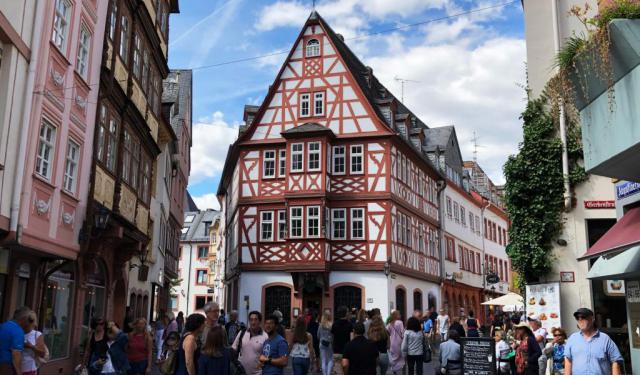Kurfürstliches Schloss (Electoral Palace), Mainz
The Electoral Palace in Mainz (Kurfürstliches Schloss zu Mainz) is a former residence of the Prince-elector and Archbishop of Mainz, representing one of Germany's significant Renaissance structures. Construction began in 1627 under Archbishop Georg Friedrich von Greiffenklau. However, due to disruptions from the Thirty Years' War and the War of the Grand Alliance, its completion was delayed. The Rhine wing, initially started in 1627, was only completed in 1678.
The original design is unknown, but it was likely intended as a four-winged building, similar to Schloss Johannisberg’s 1604 renovations. Construction of the north wing began in 1687 and finished by 1752, with interiors furnished gradually. Later expansions, particularly under Archbishops Johann Friedrich Karl von Ostein and Friedrich Karl Josef von Erthal, occurred before political shifts during the Napoleonic period moved the archbishopric's seat to Regensburg. War delays and competition for resources, including the destruction of Lustschloss Favorite in 1793, hindered progress. The palace was neglected after the last Elector’s expulsion but restored in 1827 by Hesse-Darmstadt.
During World War II, the palace was heavily damaged in the 1945 air raid, leaving only the exterior walls. It was restored between 1948 and 1949 and reopened for public use by the end of 1949. The palace served as the main venue for Mainz's Carnival activities until the opening of Rheingold Hall in 1968.
Architecturally, the palace is among the last examples of German Renaissance design. Its northern wing, built later, remains true to this style, with richly ornamented exteriors, particularly around the windows. The palace once housed the Grand Staircase, a Baroque masterpiece by Balthasar Neumann, removed during the French occupation. Today, the east wing hosts the Roman-Germanic Central Museum (Römisch-Germanisches Zentralmuseum), while the north wing contains the hall used for the renowned Mainz carnival broadcast, Mainz remains Mainz, as it sings and laughs (Mainz bleibt Mainz, wie es singt und lacht).
Managed by Congress Centrum Mainz, the Electoral Palace offers a variety of spaces for events, accommodating up to 1,700 guests across seven halls and smaller rooms.
The original design is unknown, but it was likely intended as a four-winged building, similar to Schloss Johannisberg’s 1604 renovations. Construction of the north wing began in 1687 and finished by 1752, with interiors furnished gradually. Later expansions, particularly under Archbishops Johann Friedrich Karl von Ostein and Friedrich Karl Josef von Erthal, occurred before political shifts during the Napoleonic period moved the archbishopric's seat to Regensburg. War delays and competition for resources, including the destruction of Lustschloss Favorite in 1793, hindered progress. The palace was neglected after the last Elector’s expulsion but restored in 1827 by Hesse-Darmstadt.
During World War II, the palace was heavily damaged in the 1945 air raid, leaving only the exterior walls. It was restored between 1948 and 1949 and reopened for public use by the end of 1949. The palace served as the main venue for Mainz's Carnival activities until the opening of Rheingold Hall in 1968.
Architecturally, the palace is among the last examples of German Renaissance design. Its northern wing, built later, remains true to this style, with richly ornamented exteriors, particularly around the windows. The palace once housed the Grand Staircase, a Baroque masterpiece by Balthasar Neumann, removed during the French occupation. Today, the east wing hosts the Roman-Germanic Central Museum (Römisch-Germanisches Zentralmuseum), while the north wing contains the hall used for the renowned Mainz carnival broadcast, Mainz remains Mainz, as it sings and laughs (Mainz bleibt Mainz, wie es singt und lacht).
Managed by Congress Centrum Mainz, the Electoral Palace offers a variety of spaces for events, accommodating up to 1,700 guests across seven halls and smaller rooms.
Want to visit this sight? Check out these Self-Guided Walking Tours in Mainz. Alternatively, you can download the mobile app "GPSmyCity: Walks in 1K+ Cities" from Apple App Store or Google Play Store. The app turns your mobile device to a personal tour guide and it works offline, so no data plan is needed when traveling abroad.
Kurfürstliches Schloss (Electoral Palace) on Map
Sight Name: Kurfürstliches Schloss (Electoral Palace)
Sight Location: Mainz, Germany (See walking tours in Mainz)
Sight Type: Attraction/Landmark
Sight Location: Mainz, Germany (See walking tours in Mainz)
Sight Type: Attraction/Landmark
Walking Tours in Mainz, Germany
Create Your Own Walk in Mainz
Creating your own self-guided walk in Mainz is easy and fun. Choose the city attractions that you want to see and a walk route map will be created just for you. You can even set your hotel as the start point of the walk.
In the Footsteps of Gutenberg
The capital of Rhineland-Palatinate, Mainz has made a name throughout the world as Gutenberg's city, the birthplace of Johannes Gutenberg and his great invention, the first movable metal-type printing press. It is precisely for this important heritage that Mainz has retained its importance as a hub for some of Germany's oldest publishing houses.
Following in the footsteps of Gutenberg... view more
Tour Duration: 1 Hour(s)
Travel Distance: 1.2 Km or 0.7 Miles
Following in the footsteps of Gutenberg... view more
Tour Duration: 1 Hour(s)
Travel Distance: 1.2 Km or 0.7 Miles
Mainz Introduction Walking Tour
Mainz is the Rhineland-Palatinate state capital and its largest city. It is located on the Rhine river, where the Main river joins the Rhine. Mainz has remained a prosperous city and is an important container port hub.
Mainz was founded as a Roman military fortress in the 1st century BC. The Roman stronghold was called Mogontiacum. Visitors can see several Roman shipwrecks and learn more about... view more
Tour Duration: 2 Hour(s)
Travel Distance: 3.3 Km or 2.1 Miles
Mainz was founded as a Roman military fortress in the 1st century BC. The Roman stronghold was called Mogontiacum. Visitors can see several Roman shipwrecks and learn more about... view more
Tour Duration: 2 Hour(s)
Travel Distance: 3.3 Km or 2.1 Miles





